Yiming Zeng
RAPID Hand: A Robust, Affordable, Perception-Integrated, Dexterous Manipulation Platform for Generalist Robot Autonomy
Jun 09, 2025
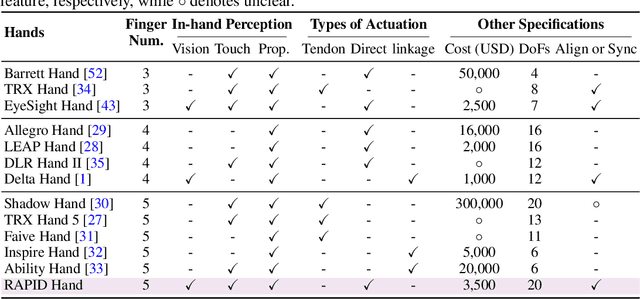
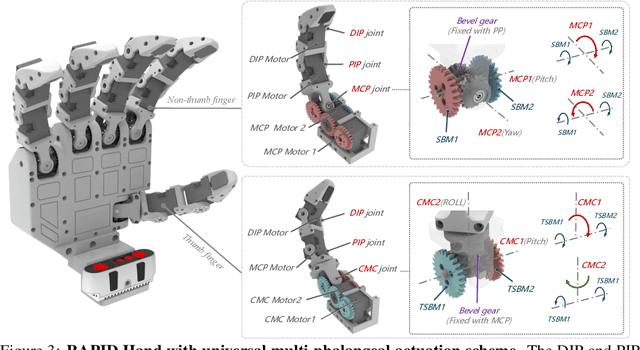
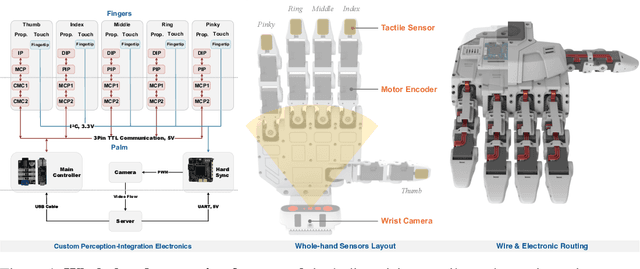
Abstract:This paper addresses the scarcity of low-cost but high-dexterity platforms for collecting real-world multi-fingered robot manipulation data towards generalist robot autonomy. To achieve it, we propose the RAPID Hand, a co-optimized hardware and software platform where the compact 20-DoF hand, robust whole-hand perception, and high-DoF teleoperation interface are jointly designed. Specifically, RAPID Hand adopts a compact and practical hand ontology and a hardware-level perception framework that stably integrates wrist-mounted vision, fingertip tactile sensing, and proprioception with sub-7 ms latency and spatial alignment. Collecting high-quality demonstrations on high-DoF hands is challenging, as existing teleoperation methods struggle with precision and stability on complex multi-fingered systems. We address this by co-optimizing hand design, perception integration, and teleoperation interface through a universal actuation scheme, custom perception electronics, and two retargeting constraints. We evaluate the platform's hardware, perception, and teleoperation interface. Training a diffusion policy on collected data shows superior performance over prior works, validating the system's capability for reliable, high-quality data collection. The platform is constructed from low-cost and off-the-shelf components and will be made public to ensure reproducibility and ease of adoption.
NaviDiffusor: Cost-Guided Diffusion Model for Visual Navigation
Apr 14, 2025Abstract:Visual navigation, a fundamental challenge in mobile robotics, demands versatile policies to handle diverse environments. Classical methods leverage geometric solutions to minimize specific costs, offering adaptability to new scenarios but are prone to system errors due to their multi-modular design and reliance on hand-crafted rules. Learning-based methods, while achieving high planning success rates, face difficulties in generalizing to unseen environments beyond the training data and often require extensive training. To address these limitations, we propose a hybrid approach that combines the strengths of learning-based methods and classical approaches for RGB-only visual navigation. Our method first trains a conditional diffusion model on diverse path-RGB observation pairs. During inference, it integrates the gradients of differentiable scene-specific and task-level costs, guiding the diffusion model to generate valid paths that meet the constraints. This approach alleviates the need for retraining, offering a plug-and-play solution. Extensive experiments in both indoor and outdoor settings, across simulated and real-world scenarios, demonstrate zero-shot transfer capability of our approach, achieving higher success rates and fewer collisions compared to baseline methods. Code will be released at https://github.com/SYSU-RoboticsLab/NaviD.
Prior Does Matter: Visual Navigation via Denoising Diffusion Bridge Models
Apr 14, 2025Abstract:Recent advancements in diffusion-based imitation learning, which show impressive performance in modeling multimodal distributions and training stability, have led to substantial progress in various robot learning tasks. In visual navigation, previous diffusion-based policies typically generate action sequences by initiating from denoising Gaussian noise. However, the target action distribution often diverges significantly from Gaussian noise, leading to redundant denoising steps and increased learning complexity. Additionally, the sparsity of effective action distributions makes it challenging for the policy to generate accurate actions without guidance. To address these issues, we propose a novel, unified visual navigation framework leveraging the denoising diffusion bridge models named NaviBridger. This approach enables action generation by initiating from any informative prior actions, enhancing guidance and efficiency in the denoising process. We explore how diffusion bridges can enhance imitation learning in visual navigation tasks and further examine three source policies for generating prior actions. Extensive experiments in both simulated and real-world indoor and outdoor scenarios demonstrate that NaviBridger accelerates policy inference and outperforms the baselines in generating target action sequences. Code is available at https://github.com/hren20/NaiviBridger.
OPG-Policy: Occluded Push-Grasp Policy Learning with Amodal Segmentation
Mar 06, 2025Abstract:Goal-oriented grasping in dense clutter, a fundamental challenge in robotics, demands an adaptive policy to handle occluded target objects and diverse configurations. Previous methods typically learn policies based on partially observable segments of the occluded target to generate motions. However, these policies often struggle to generate optimal motions due to uncertainties regarding the invisible portions of different occluded target objects across various scenes, resulting in low motion efficiency. To this end, we propose OPG-Policy, a novel framework that leverages amodal segmentation to predict occluded portions of the target and develop an adaptive push-grasp policy for cluttered scenarios where the target object is partially observed. Specifically, our approach trains a dedicated amodal segmentation module for diverse target objects to generate amodal masks. These masks and scene observations are mapped to the future rewards of grasp and push motion primitives via deep Q-learning to learn the motion critic. Afterward, the push and grasp motion candidates predicted by the critic, along with the relevant domain knowledge, are fed into the coordinator to generate the optimal motion implemented by the robot. Extensive experiments conducted in both simulated and real-world environments demonstrate the effectiveness of our approach in generating motion sequences for retrieving occluded targets, outperforming other baseline methods in success rate and motion efficiency.
Bridging the Editing Gap in LLMs: FineEdit for Precise and Targeted Text Modifications
Feb 19, 2025Abstract:Large Language Models (LLMs) have transformed natural language processing, yet they still struggle with direct text editing tasks that demand precise, context-aware modifications. While models like ChatGPT excel in text generation and analysis, their editing abilities often fall short, addressing only superficial issues rather than deeper structural or logical inconsistencies. In this work, we introduce a dual approach to enhance LLMs editing performance. First, we present InstrEditBench, a high-quality benchmark dataset comprising over 20,000 structured editing tasks spanning Wiki articles, LaTeX documents, code, and database Domain-specific Languages (DSL). InstrEditBench is generated using an innovative automated workflow that accurately identifies and evaluates targeted edits, ensuring that modifications adhere strictly to specified instructions without altering unrelated content. Second, we propose FineEdit, a specialized model trained on this curated benchmark. Experimental results demonstrate that FineEdit achieves significant improvements around {10\%} compared with Gemini on direct editing tasks, convincingly validating its effectiveness.
Infant Agent: A Tool-Integrated, Logic-Driven Agent with Cost-Effective API Usage
Nov 02, 2024



Abstract:Despite the impressive capabilities of large language models (LLMs), they currently exhibit two primary limitations, \textbf{\uppercase\expandafter{\romannumeral 1}}: They struggle to \textbf{autonomously solve the real world engineering problem}. \textbf{\uppercase\expandafter{\romannumeral 2}}: They remain \textbf{challenged in reasoning through complex logic problems}. To address these challenges, we developed the \textsc{Infant Agent}, integrating task-aware functions, operators, a hierarchical management system, and a memory retrieval mechanism. Together, these components enable large language models to sustain extended reasoning processes and handle complex, multi-step tasks efficiently, all while significantly reducing API costs. Using the \textsc{Infant Agent}, GPT-4o's accuracy on the SWE-bench-lite dataset rises from $\mathbf{0.33\%}$ to $\mathbf{30\%}$, and in the AIME-2024 mathematics competition, it increases GPT-4o's accuracy from $\mathbf{13.3\%}$ to $\mathbf{37\%}$.
Dynamic 3D Point Cloud Sequences as 2D Videos
Mar 02, 2024Abstract:Dynamic 3D point cloud sequences serve as one of the most common and practical representation modalities of dynamic real-world environments. However, their unstructured nature in both spatial and temporal domains poses significant challenges to effective and efficient processing. Existing deep point cloud sequence modeling approaches imitate the mature 2D video learning mechanisms by developing complex spatio-temporal point neighbor grouping and feature aggregation schemes, often resulting in methods lacking effectiveness, efficiency, and expressive power. In this paper, we propose a novel generic representation called \textit{Structured Point Cloud Videos} (SPCVs). Intuitively, by leveraging the fact that 3D geometric shapes are essentially 2D manifolds, SPCV re-organizes a point cloud sequence as a 2D video with spatial smoothness and temporal consistency, where the pixel values correspond to the 3D coordinates of points. The structured nature of our SPCV representation allows for the seamless adaptation of well-established 2D image/video techniques, enabling efficient and effective processing and analysis of 3D point cloud sequences. To achieve such re-organization, we design a self-supervised learning pipeline that is geometrically regularized and driven by self-reconstructive and deformation field learning objectives. Additionally, we construct SPCV-based frameworks for both low-level and high-level 3D point cloud sequence processing and analysis tasks, including action recognition, temporal interpolation, and compression. Extensive experiments demonstrate the versatility and superiority of the proposed SPCV, which has the potential to offer new possibilities for deep learning on unstructured 3D point cloud sequences. Code will be released at https://github.com/ZENGYIMING-EAMON/SPCV.
Distilling Functional Rearrangement Priors from Large Models
Dec 03, 2023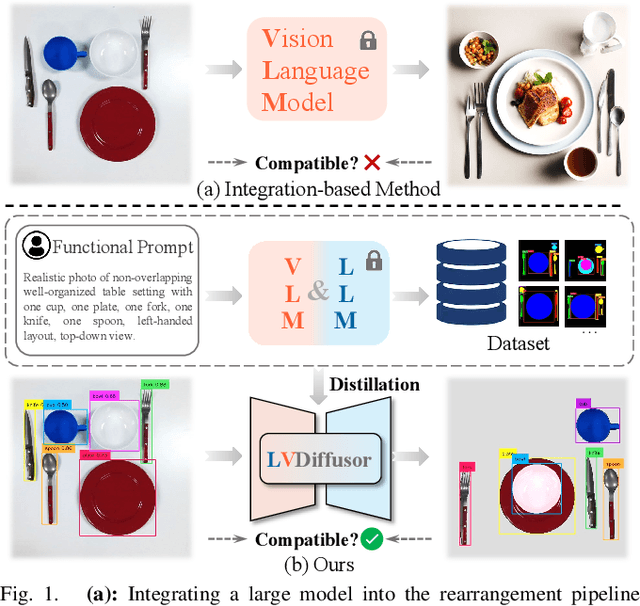
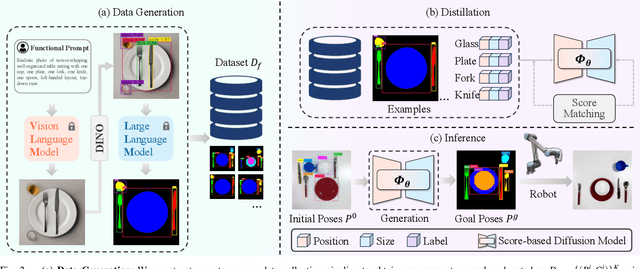
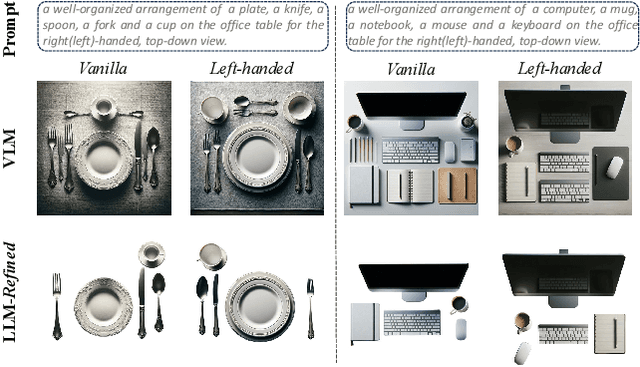

Abstract:Object rearrangement, a fundamental challenge in robotics, demands versatile strategies to handle diverse objects, configurations, and functional needs. To achieve this, the AI robot needs to learn functional rearrangement priors in order to specify precise goals that meet the functional requirements. Previous methods typically learn such priors from either laborious human annotations or manually designed heuristics, which limits scalability and generalization. In this work, we propose a novel approach that leverages large models to distill functional rearrangement priors. Specifically, our approach collects diverse arrangement examples using both LLMs and VLMs and then distills the examples into a diffusion model. During test time, the learned diffusion model is conditioned on the initial configuration and guides the positioning of objects to meet functional requirements. In this manner, we create a handshaking point that combines the strengths of conditional generative models and large models. Extensive experiments on multiple domains, including real-world scenarios, demonstrate the effectiveness of our approach in generating compatible goals for object rearrangement tasks, significantly outperforming baseline methods.
Flattening-Net: Deep Regular 2D Representation for 3D Point Cloud Analysis
Dec 17, 2022



Abstract:Point clouds are characterized by irregularity and unstructuredness, which pose challenges in efficient data exploitation and discriminative feature extraction. In this paper, we present an unsupervised deep neural architecture called Flattening-Net to represent irregular 3D point clouds of arbitrary geometry and topology as a completely regular 2D point geometry image (PGI) structure, in which coordinates of spatial points are captured in colors of image pixels. \mr{Intuitively, Flattening-Net implicitly approximates a locally smooth 3D-to-2D surface flattening process while effectively preserving neighborhood consistency.} \mr{As a generic representation modality, PGI inherently encodes the intrinsic property of the underlying manifold structure and facilitates surface-style point feature aggregation.} To demonstrate its potential, we construct a unified learning framework directly operating on PGIs to achieve \mr{diverse types of high-level and low-level} downstream applications driven by specific task networks, including classification, segmentation, reconstruction, and upsampling. Extensive experiments demonstrate that our methods perform favorably against the current state-of-the-art competitors. We will make the code and data publicly available at https://github.com/keeganhk/Flattening-Net.
CorrI2P: Deep Image-to-Point Cloud Registration via Dense Correspondence
Jul 12, 2022



Abstract:Motivated by the intuition that the critical step of localizing a 2D image in the corresponding 3D point cloud is establishing 2D-3D correspondence between them, we propose the first feature-based dense correspondence framework for addressing the image-to-point cloud registration problem, dubbed CorrI2P, which consists of three modules, i.e., feature embedding, symmetric overlapping region detection, and pose estimation through the established correspondence. Specifically, given a pair of a 2D image and a 3D point cloud, we first transform them into high-dimensional feature space and feed the resulting features into a symmetric overlapping region detector to determine the region where the image and point cloud overlap each other. Then we use the features of the overlapping regions to establish the 2D-3D correspondence before running EPnP within RANSAC to estimate the camera's pose. Experimental results on KITTI and NuScenes datasets show that our CorrI2P outperforms state-of-the-art image-to-point cloud registration methods significantly. We will make the code publicly available.
 Add to Chrome
Add to Chrome Add to Firefox
Add to Firefox Add to Edge
Add to Edge